Exam 3 flashcards BIOL416
1/80
There's no tags or description
Looks like no tags are added yet.
Name | Mastery | Learn | Test | Matching | Spaced |
|---|
No study sessions yet.
81 Terms
1. Which of the following types of lipids is the most abundant in the plasma
membrane?
a. phospholipids
b. glycolipids
c. sterols
d. triacylglycerides
a. phospholipids
2. Which of the following membrane lipids does not contain a fatty acid tail?
a. phosphatidylcholine
b. a glycolipid
c. phosphatidylserine
d. cholesterol
d. cholesterol
3. Where does most new membrane synthesis take place in a eukaryotic cell?
a. in the Golgi apparatus
b. in the endoplasmic reticulum
c. in the plasma membrane
d. on ribosomes
b. in the endoplasmic reticulum
. Membrane lipids are capable of many different types of movement. Which of these
does NOT occur spontaneously in biological membranes?
a. moving between lipid layers
b. lateral movement
c. rotation around the long axis of a fatty acid
d. flexing of hydrocarbon chains
a. moving between lipid layer
5. Most animal fats form solids at room temperature, while plant fats remain liquid at
room temperature. Which of the following is a feature of plant lipids that best
explains this difference?
a. unsaturated hydrocarbons
b. longer hydrocarbon tails
c. higher levels of sterols
d. larger head groups
a. unsaturated hydrocarbons
6. Membrane synthesis in the cell requires the regulation of growth for both halves of
the bilayer and the selective retention of certain types of lipids on one side or the
other. Which group of enzymes accomplishes both tasks?
a. flippases
b. phospholipases
c. convertases
d. glycosylases
a. flippases
7.We know the detailed molecular structure and mechanism of action of the
transmembrane protein bacteriorhodopsin. This protein uses sunlight as the source
of energy to pump __________ out of the cell.
a. ATP
b. H+
c. K+
d. Na+
b. H+
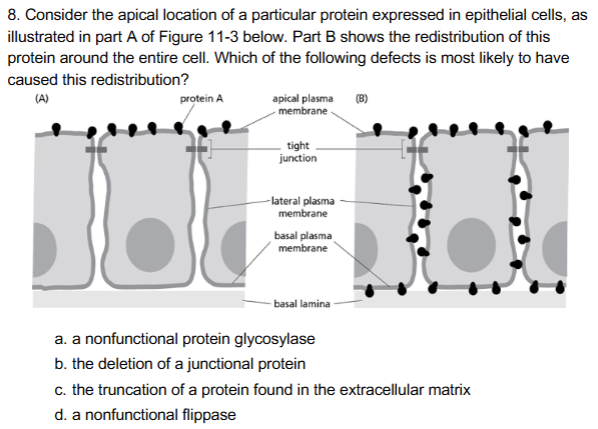
a. a nonfunctional protein glycosylase
b. the deletion of a junctional protein
c. the truncation of a protein found in the extracellular matrix
d. a nonfunctional flippase
9. Consider a transport vesicle containing a membrane glycoprotein. The
glycoprotein and the vesicle’s phospholipids are delivered to the plasma membrane,
as shown in the figure below. Which of the following is an accurate description of the
outcome of this process?
b. the deletion of a junctional protein

a. The portion of the glycoprotein that was inside of the vesicle ends up in the
cytosol after it is delivered to the plasma membrane.
b. The phospholipids that are delivered to the noncytosolic face of the plasma
membrane used to be in the interior (luminal) face of the vesicle.
c. The fusion event between the vesicle and the plasma membrane
randomizes the phospholipids between the cytosolic and noncytosolic faces
of the bilayer.
d. Some of the individual phospholipid molecules are released into the cytosol
to prevent the plasma membrane, and thus the cell, from becoming too
large.
b. The phospholipids that are delivered to the noncytosolic face of the plasma
membrane used to be in the interior (luminal) face of the vesicle.
10. It is your turn to present a research article from the literature at a weekly
lunchtime “brown bag” seminar that you attend with your fellow graduate students.
The topic of the seminar is plasma membrane proteins. As you begin discussing
your chosen article, you notice that your colleagues have curious looks on their
faces. In a wave of embarrassment, you realize that the curious looks are related to
the protein featured in your chosen article. Which protein is most likely to be
responsible for your blunder?
a. adenylyl cyclase, an enzyme that produces cyclic AMP
b. Na+ pump, an ion transporter
c. integrin, an anchoring protein
d. glycosylase, a DNA repair enzyme
d. glycosylase, a DNA repair enzyme
11. Explain the reasons why membrane proteins are more difficult to isolate and
purify for in vitro studies compared to cytosolic proteins
Answer: Cytosolic proteins are soluble in aqueous solutions. They can be isolated
fairly easily from the soluble fraction of a cell lysate. Membrane proteins contain both
hydrophilic and hydrophobic segments and need to be isolated in association with
micelles (vesicles that form when the bilayer is disrupted) to retain their active
conformation and prevent aggregation
2. Sodium dodecyl sulfate (SDS) and Triton X-100 are both detergents that can be
used to lyse cells to study individual components. Your first project as a Ph.D.
student is to create an in vitro model that allows you to study the mechanism of
action of a novel glucose transporter protein. You use SDS to lyse the cells. Later
experiments demonstrate that the transporter is not functional. Provide a possible
explanation for what happened, propose a solution for your next experiment, and
articulate the reasons you think the new method will be more successful.
Answer: SDS is a strong ionic detergent. When cells are exposed to SDS, membrane
proteins are not only extracted from the membrane; they are completely unfolded. After
denaturation, they cannot be studied as functional molecules. Therefore, it is likely that
your use of SDS for cell lysis denatured and inactivated the transporter protein. Using a
milder detergent like Triton X-100 would be a single change that might yield better
results. Triton X-100 is amphipathic, having a smaller nonpolar portion and a polar but
uncharged end, which allows it to mimic more closely the type of solvation effect of the
membrane lipids. Triton X-100 may form a shell around the hydrophobic portion of the
protein without disrupting the existing structure. This makes it possible to then place
the active transporter protein into a new, synthetic membrane bilayer for study in vitro.
1. Which of the following channels would NOT be expected to generate a change in
voltage by movement of its substrate across the membrane?
a. an aquaporin
b. a sodium channel
c. a calcium channel
d. a proton channel
a. an aquaporin
2. Cells use membranes to help maintain set ranges of ion concentrations inside
and outside the cell. Which of the following ions is the most abundant inside a
typical mammalian cell?
a. Na+
b. K+
c. Ca2+
d. Cl-
b. K+
. Cells use membranes to help maintain set ranges of ion concentrations inside
and outside the cell. Which of the following ions is the most abundant outside a
typical mammalian cell?
a. Na+
b. K+
c. Ca2+
d. Cl-
a. Na+
4. Which of the following statements about resting membrane potential is true?
a. The resting membrane potential for most animal cells is zero mV, because
the positive and negative ions are in balance.
b. The resting membrane potential for most animal cells is positive, because
Na+ ions are so plentiful inside cells.
c. The resting membrane potential for most animal cells is negative, because
the inside of the cell is more negatively charged than the outside of the cell.
d. At the resting membrane potential, no ions enter or exit the cell.
c. The resting membrane potential for most animal cells is negative, because the inside of the cell is more negatively charged than the outside of the cell.
5. Some cells express aquaporin proteins—they are channel proteins that facilitate
the flow of water molecules through the plasma membrane. What regulates the rate
and direction of water diffusion across the membrane?
a. aquaporin conformation
b. resting membrane potential
c. the concentration of water on either side of the membrane
d. availability of ATP
c. the concentration of water on either side of the membrane.
6. Active transport requires the input of energy into a system so as to move solutes
against their electrochemical and concentration gradients. Which of the following is
NOT one of the common ways to perform active transport?
a. Na+-coupled
b. K+-coupled
c. ATP-driven
d. light-driven
b. K+-coupled
7. If the K+ concentration increases in extracellular space, the membrane potential of
a cell will become
a. hyperpolarized.
b. repolarized.
c. depolarized.
d. stabilized, because the membrane is not permeable to K+
c. depolarized.
8. Which of the following best describes the behavior of a gated channel?
a. It stays open continuously when stimulated.
b. It opens more frequently in response to a given stimulus.
c. It opens more widely as the stimulus becomes stronger.
d. It requires a stimulus to change from closed to open.
b. It opens more frequently in response to a given stimulus.
9. What is the primary purpose of the K+ leak channels in the gut epithelial cells?
a. to maintain the positive charge in the extracellular space
b. to keep the extracellular space negatively charged
c. to keep the Na+ pump fully functional
d. to regulate the Na+/glucose transporter so that it is only functional when
food is present
c. to keep the Na+ pump fully functional
10. If Na+ channels are opened in a cell that was previously at rest, how will the
resting membrane potential be affected?
a. Na+ does not affect the membrane potential.
b. It becomes more negative.
c. It becomes more positive.
d. It is permanently reset.
c. It becomes more positive.
11. Which of the following is required for the secretion of neurotransmitters in
response to an action potential?
a. neurotransmitter receptors
b. Na+-K+ pumps
c. voltage-gated K+ channels
d. voltage-gated Ca2+ channels
d. voltage-gated Ca2+ channels.
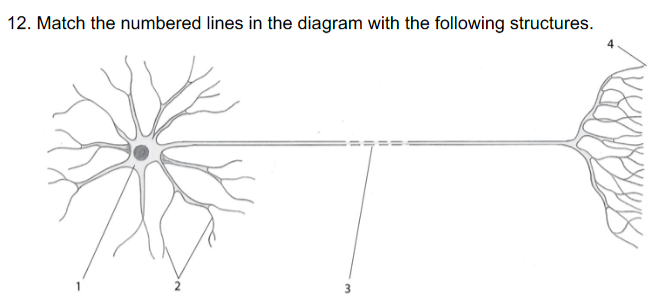
a. nerve terminal
b. cell body
c. axon
d. dendrite
. Which of the following statements about the endoplasmic reticulum (ER) is
FALSE?
a. The ER is the major site for new membrane synthesis in the cell.
b. Proteins to be delivered to the ER lumen are synthesized on the smooth
ER.
c. Steroid hormones are synthesized on the smooth ER.
d. The ER membrane is contiguous with the outer nuclear membrane.
b. Proteins to be delivered to the ER lumen are synthesized on the rough ER.
2. Which of the following organelles is NOT part of the endomembrane system?
a. Golgi apparatus
b. endosome
c. mitochondria
d. lysosomes
c. mitochondria
3. Proteins that are fully translated in the cytosol and lack a sorting signal will end up
in the
a. cytosol.
b. mitochondria.
c. interior of the nucleus.
d. nuclear membrane
a. cytosol.
4. Which of the following statements about nuclear transport is true?
a. mRNAs and proteins transit the nucleus through different types of nuclear
pores.
b. Nuclear import receptors bind to proteins in the cytosol and bring the
proteins to the nuclear pores, where the proteins are released from the
receptors into the pores for transit into the nucleus.
c. Nuclear pores contain proteins with disordered segments that fill the
channel and allow small water-soluble molecules to pass through in a
nonselective fashion.
d. Nuclear pores are made up of many copies of a single protein.
c. Nuclear pores contain proteins with disordered segments that fill the
channel and allow small water-soluble molecules to pass through in a
nonselective fashion.
5. Your friend works for a biotechnology company and has discovered a drug that
blocks the ability of Ran to exchange GDP for GTP. What is the most likely effect
of this drug on nuclear transport?
a. Nuclear transport receptors would be unable to bind cargo.
b. Nuclear transport receptors would be unable to enter the nucleus.
c. Nuclear transport receptors would be unable to release their cargo in the
nucleus.
d. Nuclear transport receptors would interact irreversibly with the nuclear pore
fibrils
c. Nuclear transport receptors would be unable to release their cargo in the nucleus.
6. Which of the following statements about transport into mitochondria and
chloroplasts is FALSE?
a. The signal sequence on proteins destined for these organelles is
recognized by a receptor protein in the outer membrane of these
organelles.
b. After a protein moves through the protein translocator in the outer
membrane of these organelles, the protein diffuses in the intermembrane
space until it encounters a protein translocator in the inner membrane.
c. Proteins that are transported into these organelles are unfolded as they are
being transported.
d. Signal peptidase will remove the signal sequence once the protein has
been imported into these organelles.
b. After a protein moves through the protein translocator in the outer
membrane of these organelles, the protein diffuses in the intermembrane
space until it encounters a protein translocator in the inner membrane.
7. Most proteins destined to enter the endoplasmic reticulum
a. are transported across the membrane after their synthesis is complete.
b. are completely translated on free ribosomes in the cytosol.
c. begin to cross the membrane while still being synthesized.
d. remain within the endoplasmic reticulum.
c. begin to cross the membrane while still being synthesized.
8. Which of the following statements is true?
a. Proteins destined for the ER are translated by a special pool of ribosomes
whose subunits are always associated with the outer ER membrane.
b. Proteins destined for the ER translocate their associated mRNAs into the
ER lumen where they are translated.
c. Proteins destined for the ER are translated by cytosolic ribosomes and are
targeted to the ER when their signal sequences emerge from the
ribosomes during translation.
d. Proteins destined for the ER are translated by a pool of cytosolic ribosomes
that contain ER-targeting sequences that interact with ER-associated
protein translocators.
c. Proteins destined for the ER are translated by cytosolic ribosomes and are targeted to the ER when their signal sequences emerge from the ribosomes during translation.
9. Your friend has just joined a lab that studies vesicle budding from the Golgi and
has been given a cell line that does not form mature vesicles. He wants to start
designing some experiments but was not listening carefully when he was told
about the molecular defect of this cell line. He is too embarrassed to ask and
comes to you for help. He does recall that this cell line forms coated pits, but
vesicle budding and the removal of coat proteins don’t happen. Which of the
following proteins might be lacking in this cell line?
a. clathrin
b. Rab
c. dynamin
d. adaptin
c. dynamin is likely missing, as it is essential for the final pinch-off of vesicles from coated pits.
10.Which of the following does NOT occur when the unfolded protein response is
activated in a cell?
a. the production of more ER membrane
b. the production of more chaperone proteins
c. the detection of misfolded proteins by receptors in the cytosol
d. the activation of gene regulatory proteins in the cytosol
c. the detection of misfolded proteins by receptors in the cytosol does NOT occur when the unfolded protein response is activated in a cell.
11.Vesicles from the ER enter the Golgi at the
a. medial cisternae.
b. trans Golgi network.
c. cis Golgi network.
d. trans cisternae.
c. cis Golgi network.
12. Which of the following is NOT a process that delivers material to the lysosome?
a. pinocytosis
b. phagocytosis
c. transcytosis
d. autophagy
c. transcytosis is NOT a process that delivers material to the lysosome, as it primarily involves the transport of materials across a cell without being delivered to lysosomes.
13.You are working at a biotech company that has discovered a small-molecule drug
called H5434. H5434 binds to LDL receptors when they are bound to LDL-
cholesterol. H5434 binding does not alter the conformation of the LDL receptor’s
intracellular domain. Interestingly, in vitro experiments demonstrate that addition
of H5434 increases the affinity of LDL for cholesterol and prevents LDL-
cholesterol from dissociating from the LDL receptor even in acidic conditions.
Which of the following is a reasonable prediction of what may happen when you
add H5434 to cells?
a. Cytosolic cholesterol levels will remain unchanged relative to normal cells.
b. Cytosolic cholesterol levels will decrease relative to normal cells.
c. The LDL receptor will remain on the plasma membrane.
d. The uncoating of vesicles will not occur.
b. Cytosolic cholesterol levels will decrease relative to normal cells
14.Which of the following processes should a cell activate to remove a worn-out
mitochondrion from its cytoplasm?
a. exocytosis
b. pinocytosis
c. autophagy
d. phagocytosis
c. autophagy is the process by which a cell removes worn-out organelles like mitochondria by degrading them within lysosomes.
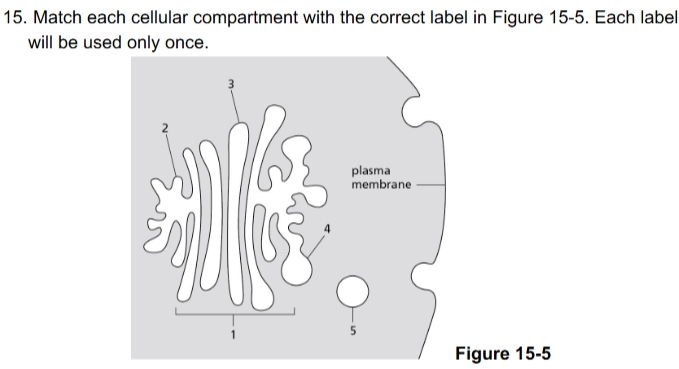
cisterna
Golgi stack
secretory vesicle
trans Golgi network
cis Golgi network
1. golgi stack
2. cis golgi network
3. cisterna
4. trans golgi network
5. secretory vesicle
1. When a signal needs to be sent to most cells throughout a multicellular organism,
the signal most suited for this is a
a. neurotransmitter.
b. hormone.
c. dissolved gas.
d. scaffold.
b. hormone is the signal most suited for systemic communication in multicellular organisms, as it is released into the bloodstream and can affect distant target cells.
2. During nervous-system development in Drosophila, the membrane-bound protein Delta acts as an inhibitory signal to prevent neighboring cells from developing into neuronal cells. Delta is involved in __________ signaling.
a. endocrine
b. paracrine
c. neuronal
d. contact-dependent
d. contact-dependent
3. Which of the following statements is true?
a. Because endocrine signals are broadcast throughout the body, all cells will
respond to the hormonal signal.
b. The regulation of inflammatory responses at the site of an infection is an
example of paracrine signaling.
c. Paracrine signaling involves the secretion of signals into the bloodstream
for distribution throughout the organism.
d. The axons of neurons typically signal target cells using membrane-bound
signaling molecules that act on receptors in the target cells.
b. The regulation of inflammatory responses at the site of an infection is an example of paracrine signaling, as it involves local cell-to-cell communication rather than widespread distribution through the bloodstream.
4. Which of the following statements about molecular switches is FALSE?
a. Phosphatases remove the phosphate from GTP on GTP-binding proteins, turning them off.
b. Protein kinases transfer the terminal phosphate from ATP onto a protein.
c. Serine/threonine kinases are the most common types of protein kinase.
d. A GTP-binding protein exchanges its bound GDP for GTP to become activated.
a. Phosphatases remove the phosphate from GTP on GTP-binding proteins, turning them off.
5. What happens when a G-protein-coupled receptor (GPCR) activates a G protein?
a. The β subunit exchanges its bound GDP for GTP.
b. The GDP bound to the α subunit is phosphorylated to form bound GTP.
c. The α subunit exchanges its bound GDP for GTP.
d. It activates the α subunit and inactivates the βγ complex.
c. The α subunit exchanges its bound GDP for GTP, leading to the activation of the G protein and initiation of downstream signaling pathways.
6. What role does GAP play in the RTK pathway?
a. GAP promotes the dephosphorylation of the intracellular domains of the
RTK receptor.
b. GAP promotes the cross phosphorylation of tyrosine residues in the
intracellular domains of the RTK receptors.
c. GAP promotes the activation of the Ras protein, which then leads to the
phosphorylation of MAP kinase pathway.
d. GAP stimulates the hydrolysis of GTP to GDP in the Ras protein, and thus helps to inactivate the RTK pathway.
d. GAP stimulates the hydrolysis of GTP to GDP in the Ras protein, and thus helps to inactivate the RTK pathway.
7. Which of the following statements is true?
a. MAP kinase is important for phosphorylating MAP kinase kinase.
b. PI 3-kinase phosphorylates a lipid in the plasma membrane.
c. Ras becomes activated when an RTK phosphorylates its bound GDP to
create GTP.
d. Dimerization of GPCRs leads to alpha subunit (Gα) activation.
b. PI 3-kinase phosphorylates a lipid in the plasma membrane, playing a crucial role in cell signaling pathways that control growth and metabolism.
8. The activation of the serine/threonine protein kinase Akt requires phosphoinositide 3-kinase (PI 3-kinase) to
a. activate the RTK.
b. create phosphorylated lipids that serve as docking sites that localize Akt to the plasma membrane.
c. directly phosphorylate Akt.
d. create DAG.
b. create phosphorylated lipids that serve as docking sites that localize Akt to the plasma membrane.

Which of the following statements is FALSE?
a. In the presence of a survival signal, Akt is phosphorylated.
b. In the absence of a survival signal, Bad inhibits the cell-death inhibitor
protein Bcl2.
c. In the presence of a survival signal, the cell-death inhibitory protein Bcl2 is
active.
d. In the absence of a survival signal, Bad is phosphorylated.
d. In the absence of a survival signal, Bad is phosphorylated.
10.When the cytosolic tail of the __________ receptor is cleaved, it migrates to the nucleus and affects gene regulation.
a. nuclear
b. Notch
c. growth factor
d. G-protein coupled
b. Notch
11.All members of the nuclear receptor family
a. are cell-surface receptors.
b. do not undergo conformational changes.
c. are found only in the cytoplasm.
d. interact with signaling molecules that diffuse through the plasma membrane.
d. interact with signaling molecules that diffuse through the plasma membrane.
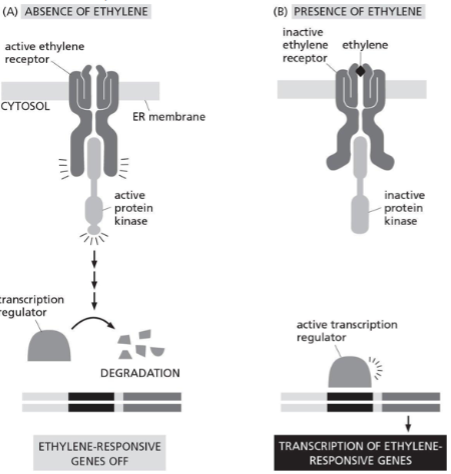
12.The ethylene response in plants involves a dimeric transmembrane receptor. When the receptor is not bound to ethylene, the receptor binds to and activates a protein kinase, which activates an intracellular signaling pathway that leads to the degradation of a transcriptional regulator important for transcribing the ethylene-responsive genes (see Figure 16-8). You discover a phosphatase that is important for ethylene signaling, and you name it PtpE. Plants lacking PtpE never turn on ethylene-responsive genes, even in the presence of ethylene. You find that PtpE dephosphorylates serine 121 on the transcriptional regulator. Furthermore, plants lacking PtpE degrade the transcriptional regulator in the presence of ethylene.
Which of the following statements is inconsistent with your data?
a. When the transcriptional regulator is phosphorylated, it activates transcription of the ethylene-responsive genes.
b. When the transcriptional regulator is not phosphorylated, it binds to DNA.
c. Activation of the protein kinase that binds to the ethylene receptor leads to
inactivation of PtpE.
d. Binding of ethylene to its receptor leads to the activation of PtpE.
a. When the transcriptional regulator is phosphorylated, it activates transcription of the ethylene-responsive genes.
13.When Ras is activated, cells will divide. A dominant-negative form of Ras clings too tightly to GDP. You introduce a dominant-negative form of Ras into cells that also have a normal version of Ras. Which of the following statements is true?
a. The cells you create will divide less frequently than normal cells in response to the extracellular signals that typically activate Ras.
b. The cells you create will run out of the GTP necessary to activate Ras.
c. The cells you create will divide more frequently compared to normal cells in
response to the extracellular signals that typically activate Ras.
d. The normal Ras in the cells you create will not be able to bind GDP
because the dominant-negative Ras binds to GDP too tightly.
a. The cells you create will divide less frequently than normal cells in response to the extracellular signals that typically activate Ras.
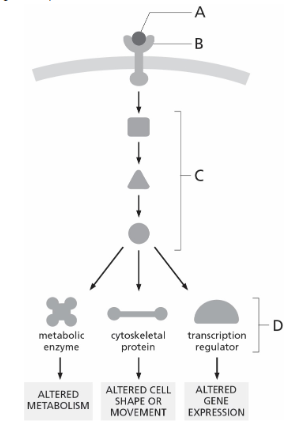
14.Given the generic signaling pathway in Figure 16-10, match the letter with its corresponding descriptor below.
receptor protein
effector proteins
intracellular signaling proteins
ligand
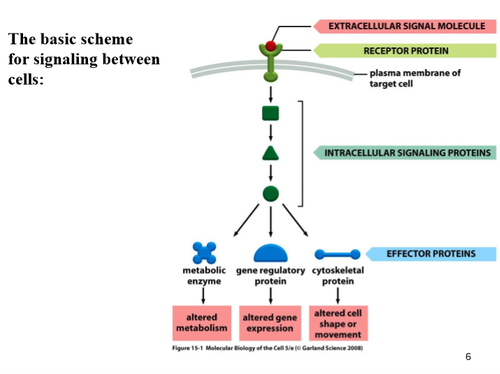
15.Antibodies are Y-shaped molecules that have two identical binding sites. Suppose that you have obtained an antibody that is specific for the extracellular domain of an RTK. When the antibody binds to the RTK, it brings together two RTK molecules. If cells containing the RTK were exposed to the antibody, would you expect the kinase to be activated, inactivated, or unaffected? Explain your reasoning.
15.Answer: The RTK will probably become activated on binding of the antibody molecule. This is because signal-induced dimerization usually activates RTKs. When RTK molecules are brought together by the antibody, their cytoplasmic kinase domains become activated, and each receptor phosphorylates the other.
1. Which of the following statements about the cytoskeleton is FALSE?
a. The cytoskeleton is made up of three types of protein filaments.
b. The cytoskeleton controls the location of organelles in eukaryotic cells.
c. Covalent bonds between protein monomers hold together cytoskeletal filaments.
d. The cytoskeleton of a cell can change in response to the environment.
c. Covalent bonds between protein monomers hold together cytoskeletal filaments; they are primarily held together by non-covalent interactions such as hydrogen bonds and van der Waals forces.
2. Which of the following statements about the cytoskeleton is true?
a. Prokaryotic cells have actin, microtubules, and intermediate filaments in
their cytoplasms.
b. The cytoskeleton provides a rigid and unchangeable structure important for
the shape of the cell.
c. The three types of cytoskeletal filaments act completely independently of
one another.
d. Actin filaments are most highly concentrated in the cell cortex, whereas microtubules traverse the cytosol.
d. Actin filaments are most highly concentrated in the cell cortex, whereas microtubules traverse the cytosol.
3. Which of the statements below about intermediate filaments in animal cells is
FALSE?
a. They can stay intact in cells treated with concentrated salt solutions.
b. They can be found in the cytoplasm and the nucleus.
c. They can be anchored to the plasma membrane at a cell–cell junction.
d. Each filament is about 25 nm in diameter.
d. Each filament is about 25 nm in diameter. Intermediate filaments have a diameter of about 10 nm, not 25 nm.
4. Which of the following is NOT a property exhibited by keratins, neurofilaments,
and vimentins?
a. They strengthen cells against mechanical stress.
b. Dimers associate by noncovalent bonding to form tetramers.
c. They are found in the cytoplasm.
d. Phosphorylation causes disassembly during every mitotic cycle.
d. Phosphorylation causes disassembly during every mitotic cycle.
5. You are studying nuclear lamins and use recombinant DNA technology to alter the coding sequence of a nuclear lamin gene. The altered gene codes for a nuclear lamin protein that can no longer be phosphorylated during prophase of mitosis. What do you predict would happen if the cell only had the altered nuclear lamin gene (and not the unaltered version)?
a. Mitosis should proceed as usual because dephosphorylation of the lamin is
what is important for nuclear lamina disassembly during mitosis.
b. Disassembly of the nuclear lamins will occur prematurely because the
lamins cannot be phosphorylated.
c. Nuclear lamins will no longer disassemble properly during mitosis.
d. Nuclear lamins will be unable to produce dimers, as the coiled-coil
formation will be disrupted.
c. Nuclear lamins will no longer disassemble properly during mitosis.
6. Which of the following statements about the structure of microtubules is FALSE?
a. Microtubules are built from protofilaments that come together to make a
hollow structure.
b. The two ends of a protofilament are chemically distinct, with α-tubulin
exposed at one end and β-tubulin exposed at the other end.
c. Within a microtubule, all protofilaments are arranged in the same
orientation, giving the microtubule structural polarity.
d. α-Tubulin and β-tubulin are covalently bound to make the tubulin dimer that
then assembles into protofilaments.
d. α-Tubulin and β-tubulin are non-covalently bound to form tubulin dimers, which then assemble into protofilaments.
7. Which of the following statements about the function of the centrosome is FALSE?
a. Microtubules emanating from the centrosome have alternating polarity such
that some have their plus end attached to the centrosome while others
have their minus end attached to the centrosome.
b. Centrosomes contain hundreds of copies of the γ-tubulin ring complex
important for microtubule nucleation.
c. Centrosomes typically contain a pair of centrioles comprised of cylindrical
arrays of short microtubules.
d. Centrosomes are the major microtubule-organizing center in animal cells
a. Microtubules emanating from the centrosome have uniform polarity with all plus ends facing away from the centrosome.
8. The hydrolysis of GTP to GDP carried out by tubulin molecules
a. provides the energy needed for tubulin to polymerize.
b. occurs because the pool of free GDP has run out.
c. tips the balance in favor of microtubule assembly.
d. allows the behavior of microtubules called dynamic instability.
d. allows the behavior of microtubules called dynamic instability.
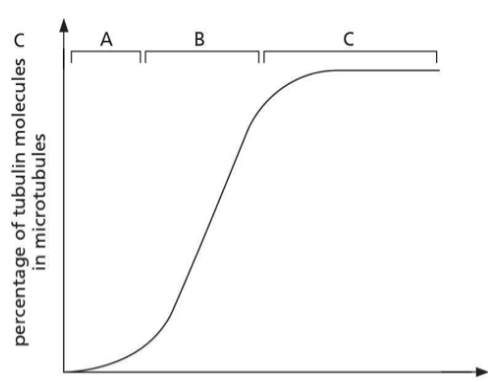
9. The graph in Figure 17-2 shows the time course of the polymerization of pure tubulin in vitro. Assume that the starting concentration of free tubulin is higher than it is in the cell cytosol. Three parts of the curve are labeled above it as A, B, and C.
You conduct a similar in vitro tubulin-polymerization experiment, only this time you include purified centrosomes in your preparation. When you plot your data, which part of your graph should be most dissimilar to the curve shown in Figure
17-2?
a. A
b. B
c. C
d. None. The shape of my graph should be identical to the graph produced
when tubulin is polymerized in the absence of purified centrosomes.
A
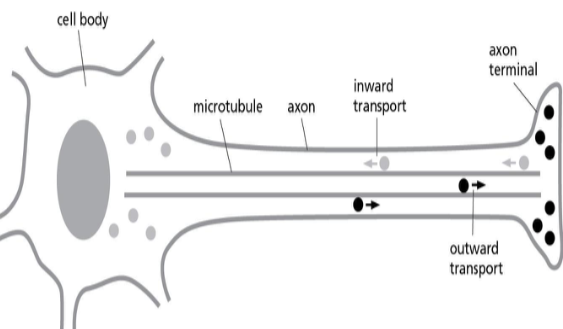
10.Microtubules are important for transporting cargo in nerve cell axons, as diagrammed in Figure 17-3. Notice that the two types of cargo are traveling in opposite directions. Which of the following statements is likely to be FALSE?
a. The gray cargo is attached to dynein.
b. The black cargo and the gray cargo require ATP hydrolysis for their motion.
c. The black cargo moving toward the axon terminal contains a domain that specifically interacts with the tail domain of a particular kind of motor.
d. The black cargo and the gray cargo are moving along microtubules of opposite polarity.
d. The black cargo and the gray cargo are moving along microtubules of opposite polarity.
11.Which of the following statements about organellar movement in the cell is FALSE?
a. Organelles undergo saltatory movement in the cell.
b. Only the microtubule cytoskeleton is involved in organellar movement.
c. Motor proteins involved in organellar movement use ATP hydrolysis for
energy.
d. Organelles are attached to the tail domain of motor proteins.
B. Only the microtubule cytoskeleton is involved in organellar movement.
12.Kinesins and dyneins
a. have tail domains that bind to microtubules.
b. move along both microtubules and actin filaments.
c. often move in opposite directions.
d. derive their energy from GTP hydrolysis
c. often move in opposite directions.
13.Which of the following statements about the movement of materials in a nerve axon is true?
a. Movement along microtubules in the axon is slower than free diffusion, but
it is necessary due to the importance of directional transport.
b. The small jerky steps seen when vesicles move along microtubules are due
to the shrinkage of microtubules that occurs when axonal microtubules
undergo dynamic instability.
c. Microtubules within an axon are arranged such that all microtubules point in the same direction with their minus ends toward the nerve cell body.
d. Microtubules within the axon support the unidirectional motion of materials
from the nerve cell body to the axon terminal, while materials transported
back from the axon terminal to the cell body move along intermediate
filaments.
c. Microtubules within an axon are arranged such that all microtubules point in the same direction with their minus ends toward the nerve cell body.
14.Which of the following components is NOT important for ciliary movement?
a. sarcoplasmic reticulum
b. ATP
c. dynein
d. microtubules
a. sarcoplasmic reticulum
15.For both actin and microtubule polymerization, nucleotide hydrolysis is important for
a. stabilizing the filaments once they are formed.
b. increasing the rate at which subunits are added to the filaments.
c. promoting nucleation of filaments.
d. decreasing the binding strength between subunits on filaments.
d. decreasing the binding strength between subunits on filaments.
16.Compared to the normal situation, in which actin monomers carry ATP, what do you predict would happen if actin monomers that bind a nonhydrolyzable form of
ATP were incorporated into actin filaments?
a. Actin filaments would grow longer.
b. Actin filaments would grow shorter because depolymerization would be
enhanced.
c. Actin filaments would grow shorter because new monomers could not be
added to the filaments.
d. No change, as the addition of monomers binding nonhydrolyzable ATP
would not affect actin filament length.
a. Actin filaments would grow longer.
17.Which of the following statements is FALSE?
a. Formins promote the formation of unbranched actin filaments.
b. Actin-binding proteins are usually excluded from the cell cortex.
c. Integrins are transmembrane proteins that can bind to the extracellular
matrix.
d. ARPs can promote the formation of branched actin filaments.
b. Actin-binding proteins are usually excluded from the cell cortex.
18.Actin-mediated movement involves the coordination of many events in the cell.
Which of the following is NOT required for cell crawling?
a. myosin-mediated contraction at the rear of the moving cell
b. integrin association with the extracellular environment
c. nucleation of new actin filaments
d. release of Ca2+ from the sarcoplasmic reticulum
d. release of Ca2+ from the sarcoplasmic reticulum
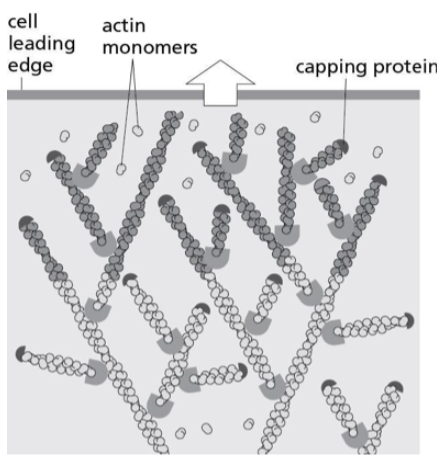
Figure 17-5 shows the leading edge of a lamellipodium. Which of the following statements is FALSE?
a. Nucleation of new filaments near the leading edge pushes the plasma membrane forward.
b. ARP proteins nucleate the branched actin filaments in the lamellipodium.
c. Capping proteins bind to the minus ends of actin filaments.
d. There is more ATP-bound actin at the leading edge than in the actin filaments away from the leading edge.
c. Capping proteins bind to the plus ends of actin filaments.
20.Your friend works in a biotech company that has just discovered a drug that seems to promote lamellipodia formation in cells. Which of the following molecules is unlikely to be directly involved in the pathway that this drug affects?
a. Rac
b. ARP
c. actin
d. myosin
d. myosin
21.Which of the following structures shortens during muscle contraction?
a. myosin filaments
b. overlap regions
c. sarcomeres
d. actin filaments
c. sarcomeres shorten as myosin heads pull on the actin filaments, leading to overall muscle contraction.
22.Which of the following conditions would decrease the likelihood of skeletal muscle contraction? (Note: this question does not consider secondary consequences of the alterations described.)
a. partial depolarization of the T-tubule membrane, such that the resting
potential is closer to zero
b. addition of a drug that blocks Ca2+ binding to troponin
c. an increase in the amount of ATP in the cell
d. a mutation in tropomyosin that decreases its affinity for the actin filament
b. addition of a drug that blocks Ca2+ binding to troponin
23. Consider the in vitro motility assay shown in Figure 17-6. It uses purified kinesin polymerized microtubules to assess the function of microtubule motor proteins. The three panels are microscopic images taken at one-second intervals. Three microtubules have been numbered to make it easy to identify them. Which of the following statements about this assay is FALSE?
a. Kinesin molecules are attached by their tails to a glass slide.
b. The microtubules used in this assay must be polymerized using conditions that stabilize tubule formation or else they would undergo dynamic instability
c. ATP must be added for this assay to work.
d. Addition of a nonhydrolyzable ATP analog (e.g., AMP-PNP) would cause the microtubules to move faster.
d. Addition of a nonhydrolyzable ATP analog (e.g., AMP-PNP) would inhibit microtubule movement by preventing kinesin from completing its power stroke.
24.If a γ-tubulin ring complex serves as a nucleation site for a single microtubule of typical structure, how many binding sites for α-tubulin does the ring complex possess? (Note detailed knowledge of the γ-tubulin ring complex might suggest a different answer from any of these.
a. 2
b. 9
c. 13
d. None. γ-tubulin ring complexes bind β-tubulin, not α-tubulin.
c. 13 binding sites for α-tubulin are typically associated with the γ-tubulin ring complex, which is crucial for microtubule nucleation.
25.Which of the following phrases best describes the function of the microtubule-associated protein augmin?
a. promotes microtubule branching
b. stabilizes existing microtubules
c. severs microtubules into smaller pieces
d. links plus ends to the cell cortex
a. promotes microtubule branching
26.Which of the following statements about skeletal muscle cells is true?
a. Most of their cytoplasmic volume consists of mitochondria.
b. The cells possess multiple nuclei.
c. Each cell contains one myofibril.
d. Contractile bundles are attached to the outsides of the cells.
b. The cells possess multiple nuclei, reflecting their development from the fusion of myoblasts.

27. Your friend discovers a protein that she names EBP. EBP binds to microtubule plus ends, and she hypothesizes a role for EBP in increasing dynamic instability. To determine the function of EBP, she examines its effect on microtubules. She polymerizes microtubules from purified centrosomes in a Petri plate and determines the number of shrinking microtubules over a three-minute time interval for different concentrations of EBP. The data she obtained are shown in
Figure 17-10.
Is this result consistent with her hypothesis? Explain.
27.Answer: No, the data graphed in Figure 17-10 are not consistent with her hypothesis. If EBP were to increase the dynamic instability of microtubules, you would expect an increase in both the number of shrinking microtubules and the number of growing microtubules. Since the graph shows a reduction in the number of shrinking microtubules, dynamic instability has evidently decreased. Further experiments would be needed to determine the net effect of these changes on microtubules and whether they become longer or shorter on average following EBP treatment.